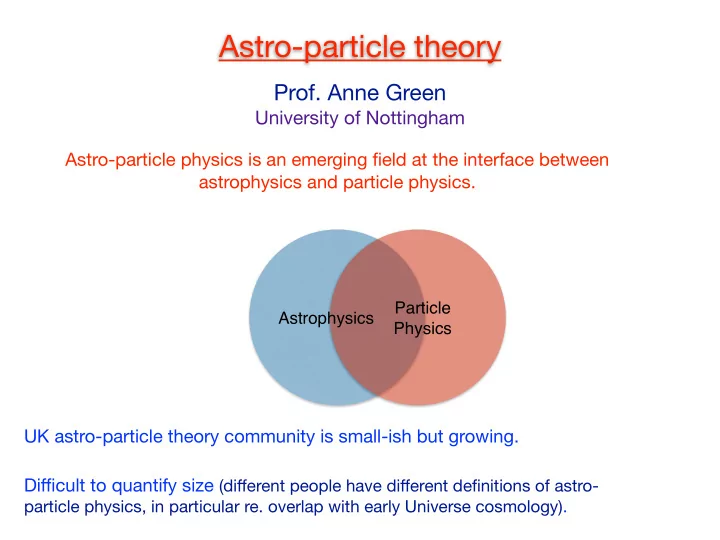

Astro-particle theory Prof. Anne Green University of Nottingham Astro-particle physics is an emerging field at the interface between astrophysics and particle physics. Particle Astrophysics Physics UK astro-particle theory community is small-ish but growing. Di ffi cult to quantify size (di ff erent people have di ff erent definitions of astro- particle physics, in particular re. overlap with early Universe cosmology).
STFC Science Roadmap Challenges A) How did the Universe begin and how is it evolving? 1) What is the physics of the early Universe? 2) How did structure first form? 3) What are the roles of dark matter and dark energy? Baryons 5% Dark matter C) What are the fundamental constituents and 26% fabric of the Universe and how do they interact? 4) What is the nature of dark matter? Dark energy 5) What is the nature of dark energy? 69% Planck
Early Universe Cosmology What generated the primordial fluctuations from which structures form? Possibly inflation , a period of accelerated expansion in early Universe, driven by a scalar field. Planck constraints on the spectral index, n s , & tensor-to-scalar ratio, r , compared with model predictions: r n s model building constraints from future observations (B-mode polarisation) Also: formation, evolution & observational signatures of topological defects phase transitions
Dark Matter Weakly Interacting Massive Particles (WIMPs) are a well-motivated dark matter candidate. Can be detected directly in lab e.g. LZ, or indirectly via annihilation products (inc. gamma- rays) e.g. CTA. Direct detection gamma-rays SuperCDMS Soudan CDMS-lite SuperCDMS Soudan Low Threshold σ SI σ A XENON 10 S2 (2013) CDMS-II Ge Low Threshold (2011) 10 � 39 10 � 3 CoGeNT DAMA S 10 � 40 (2012) 10 � 4 u p e CDMS Si PICO250-C3F8 r ) 2 C (2013) 1 d 0 l 2 o WIMP � nucleon cross section � cm 2 � ( h E s D L e P h r 10 � 41 10 � 5 WIMP � nucleon cross section � pb � M T COUPP (2012) I w S M o L DAMA n a d S u o S ) S 2 M 1 0 SNOLAB D 2 C ( I r I I e - p N u I S L 10 � 42 P 10 � 6 CDMS II Ge (2009) E Z CRESST SuperCDMS Soudan EDELWEISS (2011) 10 � 43 10 � 7 Xenon100 (2012) DarkSide 50 10 � 44 10 � 8 CNO LUX Neutrinos 3 I 8 B F C - 0 5 2 O C Neutrinos P I 10 � 45 10 � 9 DEAP3600 Xenon1T DarkSide G2 10 � 46 10 � 10 (Green&ovals)&Asymmetric&DM&& G3 Sensitivity LZ (Violet&oval)&Magne7c&DM& G3 Sensitivity 10 � 47 10 � 11 (Blue&oval)&Extra&dimensions&& (Red&circle)&SUSY&MSSM& s o n &&&&&MSSM:&Pure&Higgsino&& r i t u e N 10 � 48 10 � 12 B N &&&&&MSSM:&A&funnel& S D d n a c r i &&&&&MSSM:&BinoEstop&coannihila7on& e h p s o m t &&&&&MSSM:&BinoEsquark&coannihila7on& A 10 � 49 10 � 13 & 1 10 100 1000 10 4 WIMP Mass � GeV � c 2 � mass mass dark matter candidates theory/phenomenology signals & dependence on DM distribution Also: signatures of Axions (& ALPs) in these & other experiments/observations.
Dark Energy What is responsible for the present day accelerated expansion of the Universe? a scalar field? a modification of the laws of gravity? something else? Probe dark energy by measuring the expansion rate of the Universe & the growth of perturbations. e.g. Euclid Constraints on simple DE equation of state (p=w ρ ) parameterisation: w ( a ) = w 0 + (1 − a ) w a current Euclid projections w a w a 2 Planck +BSH Planck +WL 0.5 b � z � � 1 � z 1 Planck +BAO/RSD Planck +WL+BAO/RSD 0 w a w 1 0.0 − 1 − 2 � 0.5 − 3 − 2 − 1 0 1 � 1.2 � 1.1 � 1.0 � 0.9 � 0.8 � 0.7 w 0 w 0 w 0 w 0 model building parameterisations for data comparison
Neutrinos Constraining the neutrino masses (& hierarchy) via their e ff ects on the CMB and structure formation. Projected future constraints from DESI (dark energy spectroscopic instrument) + CMB polarisation: sum of neutrino masses mass of lightest neutrino Snowmass Dark Energy & CMB working group
Recommend
More recommend